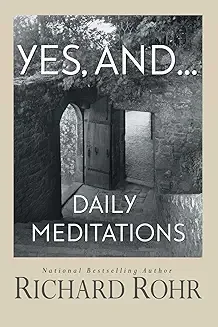Published in the Herald-Zeitung November 8, 2025
Well before entering my 80s, I thought with a bit more zeal, of what I feel a need to hang on to and what to discard. Such decisions can shift over time, but the more urgent question is: in what ways do clinging to what no longer serves not just me but others at any age, continue to burden us unnecessarily?
My favorite Franciscan writer, Father Richard Rohr’s collection in Yes, And. . . Daily Meditations, has given me further guard rails by which to discern what might be pushed beneath those rails because no longer necessary. But here is his twist: letting go is finally not about material items or even about emotional strictures that keep one ensconced in a small world of ego’s rage for control. Now, pushing it a bit, Rohr writes persuasively that letting go homes in on identities. I had not thought before reading him, that we all might possess two identities.
First, “Your little self that appears to be visible here and takes itself so seriously is merely a relative identity (whether good or bad; it is not your absolute identity that you are eternally, in God.” Then the conversation becomes thicker when he weaves several traditions of thought together: “The Buddhist idea of letting go of your attachment to your relative identity is almost identical to Jesus’s teaching of dying to yourself (or even “renouncing the self,” as in Mark 8:34).”
What is my responsibility, then, towards what I have decided to let go of? Can I answer the question: “What difference will it make?” Shall I also consider the effect it might have on others as a result of jettisoning it from my small world that cries for enlargement, for more spaciousness? Even for greater authenticity? The clock is ticking, after all!
Rohr cites Jesus’s own thinking here about “the self that must die. Go ahead and let it die, and then you will be free.” The freedom he speaks of is the one formed by becoming a part of a larger spiritual and social community that supports you and gains support from you. Perhaps culturally we have put too much emphasis on individualism, Rohr suggests, which “has made an art form of the individual person.” But what did we let go of in its service?
Reaching a level of consciousness where one sees themselves as one is and not a fantasy of what one thinks they are an provides an instance of true knowledge. Learning deepens when we notice and accept those traits in ourselves that have been denied, or we have been deluded into thinking are not real, but then not to be hostile to them but embrace them with full acceptance. Better, as Rohr encourages, turn them over to God. Being deeply transformed through both letting go and fully accepting are spiritual experiences at their core, for they rely on forgiveness. “Those who receive forgiveness can pass it on.” Now one’s individual world has expanded through an act of grace that unites us in community with others
This art form of letting go is given insightful language at the end of his meditations on this creative act: “What comes around will also go around. The art of letting go is really the secret of happiness and freedom.”
First discerning, then being willing to surrender what needs shedding, can bring us around to gaining what might not have been given its due until now: the secret.
